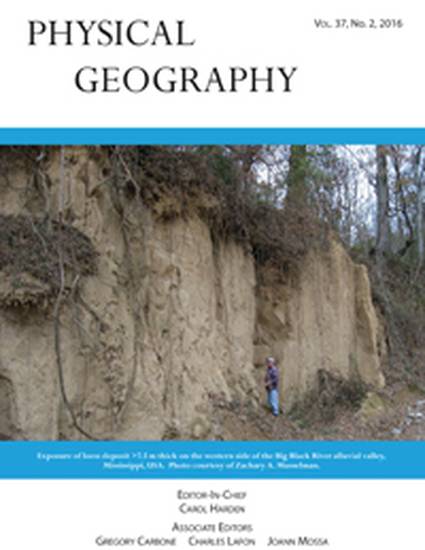
Article
Soil Development on Late-Pleistocene Moraines at Pine Creek, East-Central Sierra Nevada, California
Physical Geography
(1996)
Abstract
Late Pleistocene moraines at Pine Creek in the east-central Sierra Nevada Range are differentiated into three separate relative-age groups using soil morphological properties, with increasing soil development on progressively older deposits. Tiogaage soils (oxygen-isotope stage-2 equivalent) are weakly developed with A/AB/Bw/Cox profiles. Organic material extracted from Tioga-age till matrix has a conventional radiocarbon age of 19,570 ± 420 years B.P. Soils formed on Tahoe-age moraines (stage 4) show A/2BA/2Bw1/2Bwq2/2BC/2Cox horizonation with rubification to about 50 cm depth and slight clay enrichment. Organic matter from the Tahoe-age till matrix yields an infinite radiocarbon age (>38,000 years B.P.). Rovana moraines (stage 6) have moderate soil development, with A1/A2/2Bt1/2Bw2/2BC/2Cox profiles, conspicuous rubification down to about 103 cm, and significant clay accumulation in the Bt horizon. A soil-profile development index reflects the chronologic trend; however, lithologic and climatic variability, episodic aeolian influx, and soil erosion all confound these age trends. Our chronometric interpretations generally are consistent with rock varnish and ¹⁰Be and ²⁶Al ages from boulders resting upon the same moraines.
Keywords
- Glacial geomorphology,
- Soil development,
- Chronosequence,
- Late Pleistocene,
- Sierra Nevada
Disciplines
Publication Date
1996
Publisher Statement
Published by Taylor & Francis
Citation Information
Andrew J. Bach and Deborah Elliott-Fisk. "Soil Development on Late-Pleistocene Moraines at Pine Creek, East-Central Sierra Nevada, California" Physical Geography Vol. 17 Iss. 1 (1996) p. 1 - 28 Available at: http://works.bepress.com/andrew-bach/7/
